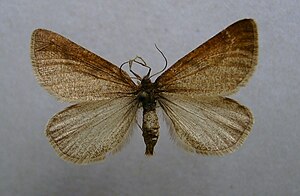Lignyoptera fumidaria
| Lignyoptera fumidaria | ||||||||||||
|---|---|---|---|---|---|---|---|---|---|---|---|---|

Lignyoptera fumidaria |
||||||||||||
| Systematics | ||||||||||||
|
||||||||||||
| Scientific name | ||||||||||||
| Lignyoptera fumidaria | ||||||||||||
| ( Huebner , 1825) |
Lignyoptera fumidaria is a butterfly ( moth ) fromthe Spanner family (Geometridae).
features
butterfly
There is a pronounced sexual dimorphism between the sexes . The wingspan of the males is 27 to 30 millimeters. The front and rear wings are mostly matt red-brown to gray-brown and almost without drawings. The area below the front edge is more intensely colored on the front wings. Sometimes a weakly darkened shadow can be seen in the area of the post-fiscal region . The hind wings always show slightly lighter shades. The flightless females have only short wing stubs, a plump body shape and are gray-brown.
egg
The egg is yellowish, oval in shape and covered with a network of short ribs. The micropyl zone is surrounded by a ring of deep pits.
Caterpillar
Adult caterpillars are green-gray in color and show seven light, wavy longitudinal lines, a dark longitudinal stripe and individual bristles. The ventral side is yellowish, the head is flesh-colored and the anus is reddish in color. When fully grown, the caterpillars can reach a length of up to 26 millimeters.
Doll
The shiny black-brown pupa is relatively wide in the front area and tapers rapidly towards the rear end. The cremaster is provided with a few thorns.
Geographical distribution and occurrence
Lignyoptera fumidaria occurs in eastern Austria , Hungary , Bulgaria , Romania and some eastern regions of the European part of Russia . The species inhabits meadow landscapes.
Way of life
The species that belongs to the frost tensioners flies in the months of October to December. In older literature, only yarrow ( Achillea millefolium ) is mentioned as a food plant for caterpillars . Experiments by Kasy showed that the caterpillars in breeding also accepted gold aster ( Galatella linosyris ), scabiosa knapweed ( Centaurea scabiosa ), meadow sage ( Salvia pratensis ) as well as plantain ( Plantago ) and elephant species ( Inula ) as fodder plants. Confirmation that these plants are also part of the diet in the field is still pending. The species overwinters as an egg.
swell
Individual evidence
- ↑ a b c Walter Forster, Theodor A. Wohlfahrt: The butterflies of Central Europe. Volume 5: Spanner. (Geometridae). Franckh'sche Verlagshandlung, Stuttgart 1981, ISBN 3-440-04951-5 .
- ↑ a b Hans Hirschke: . The first stands of lignyoptera fumidaria Hb Annual Report Vienna entomological club, 1900.
- ↑ a b c d Lignyoptera fumidaria in Fauna Europaea. Retrieved January 11, 2012
- ↑ Patrice Leraut: Geometrid moths . In: Moths of Europe . 1st edition. Volume II. NAP Editions, 2009, ISBN 978-2-913688-09-4 , pp. 88 (English).
- ↑ Hans Rebel: Fr. Berge's butterfly book according to the current state of lepidopterology , E. Schweizerbarts'sche Verlagsbuchhandlung, Stuttgart 1910.
- ^ Friedrich Kasy: The butterfly fauna of the nature reserve "Pichelsdorfer Fischawiesen", eastern Lower Austria. Journal of the Association of Austrian Entomologists, 1985.
- ↑ Friedrich Kasy: On the food plant specialization of the caterpillars of Lignyoptera fumidaria Hb. (Lepidoptera, Geometridae). Journal of the Association of Austrian Entomologists, 1990:
literature
- Walter Forster , Theodor A. Wohlfahrt : The butterflies of Central Europe. Volume 5: Spanner. (Geometridae). Franckh'sche Verlagshandlung, Stuttgart 1981, ISBN 3-440-04951-5 .
Web links
- Lepiforum e. V. Photos
- lepidoptera.pl occurrence